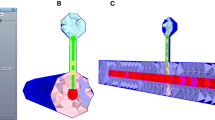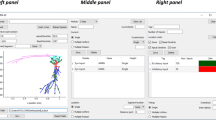Abstract
There are theories on brain functionality that can only be tested in very large models. In this work, a simulation model appropriate for working with large number of neurons was developed, and Information Theory measuring tools were designed to monitor the flow of information in such large networks. The model’s simulator can handle up to one million neurons in its current implementation by using a discretized version of the Lapicque integrate and fire neuron instead of interacting differential equations. A modular structure facilitates the setting of parameters of the neurons, networks, time and most importantly, architectural changes.
Applications of this research are demonstrated by testing architectures in terms of mutual information. We present some preliminary architectural results showing that adding a virtual analogue to white matter called “jumps” to a simple representation of cortex results in: (1) an increase in the rate of mutual information flow, corresponding to the “bias” or “priming” hypothesis; thereby giving a possible explanation of the high speed response to stimuli in complex networks. (2) An increase in the stability of response of the network; i.e. a system with “jumps” is a more reliable machine. This also has an effect on the potential speed of response.
Similar content being viewed by others
References
Abbott LF (1999) Lapicque’s introduction of the integrate-and-fire model neuron (1907). Brain Res Bull 50:303–304
Bezzi M, Diamond ME, Treves A (2002) Redundancy and synergy arising from pairwise correlations in neuronal ensembles. J Comp Neurosci 12:165–174
Braitenberg V, Schüz A (1998) Cortex: statistics and geometry of neuronal connectivity. Springer, Berlin (Revised edition of Anatomy of the cortex, statistics and geometry, 1991)
Eytan D, Marom S (2006) The network spike: a basic mode of synchronization within and between neuronal assemblies. PhD thesis, Faculty of Medicine, Technion
Fellman DJ, Van Essen DC (2001) Distributed hierarchical processing in the primate visual cortex. Cereb Cortex 1:1–47
Hodgkin AL, Huxley AF (1952) A quantitative description of membrane current and its application to conduction and excitation in nerve. J Physiol 117:500–544
Lapicque L (1907) Recherches quantitatives sur l’excitation lectrique des nerfs traite comme une polarisation. Physiol Pathol Gen 9:620–635
Marom S, Shahaf G (2002) Development, learning and memory in large random networks of cortical neurons:lesson beyond anatomy. Q Rev Biophys 35:63–87
Numerical recipes in Fortran 90 (1996) The art of scientific parallel computing, scientific computing. Cambridge University Press, Cambridge
Panzeri S, Schultz SR, Treves A, Rolls ET (1999) Correlations and encoding of information in the nervous system. Proc R Soc Lond Ser B: Biol Sci 266:1001–1012
Panzeri S, Rolls ET, Battaglia F, Lavis R (2001) Speed of feed forward and recurrent processing in multilayer networks of integrate-and-fire neurons. Network 12(4):423–440
Rolls ET, Deco G (2002) Computational neuroscience of vision. Oxford University Press, Oxford
Rolls ET, Franco L, Aggelpoulos NC, Reece S (2003) An information theoretic approach to the contributions of the firing rates and the correlations between the firing of neurons. Neurophysiol 89:2810–2822
Schüz A (1998) Neuroanatomy in a computational perspective. In: Arbib MA (ed) Handbook of brain theory and neural networks. MIT Press, Cambridge
The genesis simulator (1994–2006) http://www.genesis-sim.org/GENESIS
Trappenberg TP (2002) Fundamental of Computational Neuroscience. Oxford University Press, Oxford
Treves A, Rolls ET, Simmen M (1997) Time for retrieval in recurrent associative memories. Physica D 107:392–400
Wolfram S (2002) A new kind of science. Wolfram Media, Inc
Author information
Authors and Affiliations
Corresponding author
Rights and permissions
About this article
Cite this article
Maimon, M., Manevitz, L. A simulation tool for modeling the influence of anatomy on information flow using discrete integrate and fire neurons. J Comb Optim 15, 287–304 (2008). https://doi.org/10.1007/s10878-007-9103-3
Published:
Issue Date:
DOI: https://doi.org/10.1007/s10878-007-9103-3




